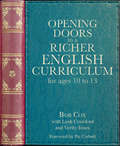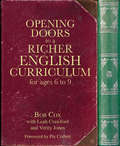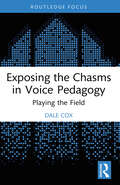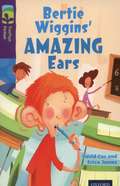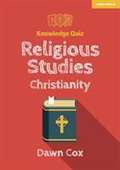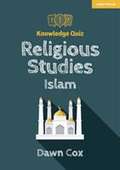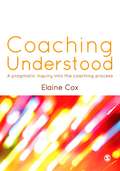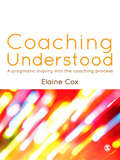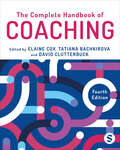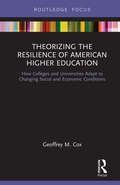- Table View
- List View
Playful Pedagogies: Young Children Learning in International and Multicultural Contexts
by Anna Cox Estelle TarryIn the 21st century what the future holds for young learners is unclear, what is clear is that they need to be confident, capable and resilient. As wider communication about education is increasing, there is a developing understanding that children in settings across the globe learn in the same ways and have the same needs. How these are best met demands reflection and effective contexts for early learning reflect the needs and demands of the communities they serve. This book considers international and multicultural learning environments from both theoretical and practical perspectives. It is written by specialists in early years education in the UK and in international contexts, all of whom have a passion for young children's learning. The theoretical perspectives are supported by eight case studies, from Uganda, Indonesia, Mexico, Qatar, Netherlands, Italy, the United Kingdom and Romania.
Teaching Assistants in International Schools: More than cutting, sticking and washing up paint pots!
by Anna Cox Estelle TarryWhere would a classroom be without a really great TA? Ask any teacher and they will tell you that the classroom just wouldn't be the same without them. However, a great teaching assistant requires training. This book, published in partnership with the Council of British International Schools, helps demonstrate how TAs can be effective in the classroom and make a real difference to learning.
Practical Pointers for University Teachers (Teaching and Learning in Higher Education)
by Cox, BillThis text aims to provide university lecturers with practical guidelines for the effective teaching and assessment of students. The topics discussed include course planning and preparation, delivery and presentation, classroom management, student feedback and much more.
Practical Pointers for University Teachers (Teaching and Learning in Higher Education)
by Cox, BillThis text aims to provide university lecturers with practical guidelines for the effective teaching and assessment of students. The topics discussed include course planning and preparation, delivery and presentation, classroom management, student feedback and much more.
Practical Pointers on Quality Assessment
by Bill Cox Amanda InglebyAimed at the higher education and further education practitioner, this title aims to build on work already done on quality assessment and to take it further by asking questions about what can be learned from assessment and how it can be developed in a positive way.
Practical Pointers on Quality Assessment
by Bill Cox Amanda InglebyAimed at the higher education and further education practitioner, this title aims to build on work already done on quality assessment and to take it further by asking questions about what can be learned from assessment and how it can be developed in a positive way.
Opening Doors to Famous Poetry and Prose: Ideas and resources for accessing literary heritage works
by Bob CoxOpening Doors provides 20 units of work which includes poetry and prose from our literary heritage. Each unit of work has exciting stimulus material with creative suggestions for ways in which the material can be used for outstanding learning possibilities. Visuals and innovative ideas to help pupils' access the meaning and wonder of the text which will add to the appeal. Pupils are encouraged, throughout the units of work, to engage with language, invent questions and write with flair and accuracy, bringing literature from the past alive for them and opening doors to further reading and exploration. Also included is an introduction to the concepts used in the book and suggestions about a range of methods and pathways which can lead to language development and literary appreciation. Although the units are all different and have a range of poetry and prose for teachers to use, each unit will have some common sections to give a coherent and ambitious approach. Opening Doors both informs and excites, it gives fresh resources and suggests new ways of going on the journey to outstanding literacy achievement. For 7-11 year olds.
Opening Doors to Quality Writing 10-13: Ideas for writing inspired by great writers
by Bob CoxIn Opening Doors to Famous Poetry and Prose, Bob Cox introduced teachers to engaging strategies which use literary heritage texts as the stimulus for excellent learning. This new companion book, Opening Doors to Quality Writing, for ages 10 to 13, puts the focus on pupils producing quality writing – developing their literacy skills and a love of reading in the process. In the course of his educational consultancy work, Bob has seen many teachers successfully use the scope and depth which literature can offer to inspire high standards, mastery learning and, above all, a love of language in its many forms. Schools using the ‘opening doors’ strategies told Bob they led to: more teacher empowerment and confidence; more knowledge building for pupils and teachers; a growing confidence with literature, including poetry; planning from the top becoming a norm; planning for mastery learning becoming a norm; improved comprehension skills; improved quality writing and associated excitement. They also asked Bob for further examples of inspiring, quality texts, and more ways in which all abilities can access them. Bob was only too happy to oblige. These 15 units of work cover poetry and prose: each unit provides exciting stimulus material, creative ideas for writing projects, and differentiation and support strategies, meaning all pupils can achieve the quality writing objectives. All the units should help teachers facilitate understanding of the challenging texts and maximise the huge potential for quality writing. Discover a multitude of ready-to-use ideas, inspired by classic literature and great writers’ works, along with plenty of new strategies and advice. Units include: Part 1: Opening doors to prose 1. Night Encounter – The Woman in White by Wilkie Collins 2. Spooky Scientists! – The Phantom Coach by Amelia B. Edwards 3. The Strongest Looking Brute in Alaska – That Spot by Jack London 4. Mr Knickerbocker’s Notes – Rip Van Winkle by Washington Irving 5. The Portrait of Doom – Tess of the D’Urbervilles by Thomas Hardy 6. The Hell Hound – The Hound of the Baskervilles by Sir Arthur Conan Doyle 7. Sinister Spaces – Metamorphosis and The Castle by Franz Kafka 8. The Mirror and the Window – Wuthering Heights by Emily Brontë Part 2: Opening doors to poetry 9. All in This House is Mossing Over – From ‘Mementos’ by Charlotte Brontë 10. Dancing the Skies – ‘High Flight’ by John Gillespie Magee, Jr 11. The Mystery of the Lonely Merman – ‘The Forsaken Merman’ by Matthew Arnold 12. Making Magic Talk – ‘The Magnifying Glass’ by Walter de la Mare 13. The Spirit in the Garden – ‘A Garden at Night’ by James Reeves 14. A Shropshire Lad – ‘Blue Remembered Hills’ by A. E. Housman 15. The Silver Heel – ‘I Started Early – Took My Dog’ by Emily Dickinson
Opening Doors to Quality Writing 6-11: Ideas for writing inspired by great writers
by Bob CoxIn Opening Doors to Famous Poetry and Prose, Bob Cox introduced teachers to engaging strategies which use literary heritage texts as the stimulus for excellent learning. This new companion book, Opening Doors to Quality Writing, for ages 6 to 9, puts the focus on pupils producing quality writing – developing their literacy skills and a love of reading in the process. In the course of his educational consultancy work, Bob has seen many teachers successfully use the scope and depth which literature can offer to inspire high standards, mastery learning and, above all, a love of language in its many forms. Schools using the ‘opening doors’ strategies told Bob they led to: more teacher empowerment and confidence; more knowledge building for pupils and teachers; a growing confidence with literature, including poetry; planning from the top becoming a norm; planning for mastery learning becoming a norm; improved comprehension skills; improved quality writing and associated excitement. They also asked Bob for further examples of inspiring, quality texts, and more ways in which pupils of all abilities can access them. Bob was only too happy to oblige. These 15 units of work cover poetry and prose: each unit provides exciting stimulus material, creative ideas for writing projects, and differentiation and support strategies, meaning all pupils can achieve the quality writing objectives. All the units should help teachers facilitate understanding of the challenging texts and maximise the huge potential for quality writing. Discover a multitude of ready-to-use ideas, inspired by classic literature and great writers’ works, along with plenty of new strategies and advice. Units include: Part 1: Opening doors to poetry 1. His Waistcoat and Trousers Were Made of Pork Chops – ‘The New Vestments’ by Edward Lear 2. Prefabulous Animiles – ‘The Hippocrump’ by James Reeves 3. Slowly the Tide Creeps Up the Sand – ‘Slowly’ by James Reeves 4. Colour Your World – ‘What is Pink?’ by Christina Rossetti 5. The Nymph and the Goblin – ‘Overheard on a Saltmarsh’ by Harold Monro 6. Pictures in My Head – ‘A Child’s Thought’ by Robert Louis Stevenson 7. He’s Behind You! – ‘The Elf Singing’ by William Allingham 8. The Sounds of Silence – ‘Lonely Street’ by Francisco López Merino 9. Pond Dipping – ‘Daddy Fell into the Pond’ by Alfred Noyes Part 2: Opening doors to prose 10. The Making of World-pap – The Water Babies: A Fairy Tale for a Land-Baby by Charles 11. Master No-book and the Fairy Teach-all – Uncle David’s Nonsensical Story about Giants and Fairies by Catherine Sinclair 12. Turning the Key – The Secret Garden by Frances Hodgson Burnett 13. The Old Oak Chest – The Riddle by Walter de la Mare 14. The Winking Scarecrow – The Wizard of Oz by L. Frank Baum 15. The Psammead – Five Children and It by E. Nesbit
Opening Doors to a Richer English Curriculum for Ages 10 to 13 (Opening Doors)
by Bob Cox Leah Crawford Verity JonesOpening Doors to a Richer English Curriculum for Ages 10 to 13 takes Bob Cox’s award-winning ‘Opening Doors’ series into bold new territories, providing a treasury of techniques and strategies all carefully selected to support the design of a deeper, more creative and more expansive curriculum.Together with Leah Crawford and Verity Jones, Bob has compiled this rich resource to help teachers enhance their learners’ engagement with challenging texts and develop their writing skills as budding wordsmiths. It includes 15 ready-to-use units of work covering a range of inspiring poetry and prose from across the literary tradition, complete with vivid illustrations by Victoria Cox.Bob, Leah and Verity’s innovative ideas on theory, best practice and how to cultivate a pioneering classroom spirit are all integrated into the lesson suggestions, which have been designed for both the teacher’s and the learners’ immediate benefit.Together they empower teachers to explore with their learners the scope and depth of literature capable of inspiring high standards and instilling a love of language in its many forms. Furthermore, they help teachers to lay down intricate curricular pathways that will prompt their pupils to better enjoy literature, read and analyse texts with a greater sense of curiosity, and write with more originality.The book includes a great range of texts both as the core of each unit and as link reading, incorporating some contemporary texts to show how past and present co-exist – and how various literary styles can be taught using similar principles, all of which are open to further adaptation. The authors have also suggested key concepts around which the curriculum can be built, with the units providing examples with which you can work.All of the extracts and illustrations you will need in order to begin opening doors in your classroom are downloadable, and the book also includes a helpful glossary of key terms.Suitable for teachers of pupils aged 10 to 13.Units include:Part 1: Opening Doors to Poetry. 1. Go and Open the Door – ‘The Door’ by Miroslav Holub. 2. One Star – ‘Speak of the North!’ by Charlotte Brontë. 3. Fire in My Head – ‘The Song of Wandering Aengus’ by W. B. Yeats. 4. Among the White Clouds – ‘Cold Mountain’ by Han-Shan. 5. The Bird That Sings – ‘Sympathy’ by Paul Laurence Dunbar. 6. Over It Dashes a Waterfall – ‘A Coloured Print by Shokei’ by Amy Lowell. 7. Old King Time! – ‘Song of Old Time’ by Eliza Cook. 8. Zoom in – ‘The Dong with a Luminous Nose’ by Edward Lear.Part 2: Opening Doors to Prose. 9. Fifty Degrees Below Zero – ‘To Build a Fire’ by Jack London. 10. The Green Door – ‘The Door in the Wall’ by H. G. Wells. 11. The Torpor of Death – The Haunted Hotel by Wilkie Collins. 12. A Home for David – David Copperfield by Charles Dickens. 13. A Ghost Mystery for Flaxman Low – ‘The Story of Baelbrow’ by E. and H. Heron. 14. Shame and Pain – Little Women by Louisa May Alcott. 15. Fake News – In Search of the Truth.
Opening Doors to a Richer English Curriculum for Ages 6 to 9 (Opening Doors)
by Bob Cox Leah Crawford Verity JonesOpening Doors to a Richer English Curriculum for Ages 6 to 9 takes Bob Cox’s award-winning ‘Opening Doors’ series into bold new territories, providing a treasury of techniques and strategies all carefully selected to support the design of a deeper, more creative and more expansive curriculum.Together with Leah Crawford and Verity Jones, Bob has compiled this rich resource to help teachers enhance their learners’ engagement with challenging texts and develop their writing skills as budding wordsmiths. It includes 15 ready-to-use units of work covering a range of inspiring poetry and prose from across the literary tradition, complete with vivid illustrations by Victoria Cox.Bob, Leah and Verity’s innovative ideas on theory, best practice and how to cultivate a pioneering classroom spirit are all integrated into the lesson suggestions, which have been designed for both the teacher’s and the learners’ immediate benefit.Together they empower teachers to explore with their learners the scope and depth of literature capable of inspiring high standards and instilling a love of language in its many forms. Furthermore, they help teachers to lay down intricate curricular pathways that will prompt their pupils to better enjoy literature, read and analyse texts with a greater sense of curiosity, and write with more originality.The book includes a great range of texts both as the core of each unit and as link reading, incorporating some contemporary texts to show how past and present co-exist – and how various literary styles can be taught using similar principles, all of which are open to further adaptation. The authors have also suggested key concepts around which the curriculum can be built, with the units providing examples with which you can work.All of the extracts and illustrations you will need in order to begin opening doors in your classroom are downloadable, and the book also includes a helpful glossary of key terms.Suitable for teachers of pupils aged 6 to 9.Units include:Part 1: Opening Doors to Poetry. 1. I Pulled a Hummingbird Out of the Sky – ‘Wind’ by Dionne Brand. 2. Do You Have Time to Stand and Stare? – ‘Leisure’ by W. H. Davies. 3. Mini-Beast Magic – ‘Hurt No Living Thing’ by Christina Rossetti. 4. How Out of Breath You Are – ‘Dear March – Come In –’ by Emily Dickinson. 5. Voices in an Empty Room – ‘Green Candles’ by Humbert Wolfe. 6. Faceless – ‘Prince Kano’ by Edward Lowbury. 7. Green-Eyed Scratcher – ‘Cat!’ by Eleanor Farjeon.Part 2: Opening Doors to Prose. 8. Foundling – ‘Over the Hills and Far Away’ by Hilary McKay and ‘Blackberry Blue’ by Jamila Gavin. 9. A Power Struggle – ‘The Frost, the Sun, and the Wind’ (Russian folk tale translated by Charles Downing). 10. Stories and More Stories – Granny’s Wonderful Chair by Frances Browne. 11. That Is Disgusting! – The American Woman’s Home by Catherine E. Beecher and Harriet Beecher Stowe. 12. Shadow in a Drawer – Peter Pan by J. M. Barrie. 13. Once Upon a Time There Was a Piece of Wood – Pinocchio by Carlo Collodi. 14. Whirlpools! – ‘The Island of the Nine Whirlpools’ by Edith Nesbit. 15. The Butterfly Dance – The Story of the Blue Planet by Andri Snær Magnason.
Exposing the Chasms in Voice Pedagogy: Playing the Field
by Dale CoxThis concise book critically examines the intersection of power, privilege, and classical music in higher education through an extensive study of the experiences, training, and background of teachers of musical theatre singing.Mapping the divides within the voice pedagogy field, it shows how despite the growth of non-classical programmes, the teaching of vocal music in the United States continues to be structurally dominated by Western classical music. Drawing on extensive fieldwork and observations of practicing instructors, the author argues that current voice pedagogy training’s classical-centred approach fails to prepare instructors to teach the range of vocal styles needed in the contemporary musical theatre profession. Combining a critical review of existing practices with proposals for change, this book sheds light on a key problem in voice pedagogy today.Based on field research and drawing on both Shulman’s signature pedagogies theory and Bourdieu’s concepts of habitus, capitals, practice, and field, this book will be useful for scholars, researchers, and practitioners of voice pedagogy, higher music education, performance education, cultural studies, music, musical theatre, and theatre studies.
Exposing the Chasms in Voice Pedagogy: Playing the Field
by Dale CoxThis concise book critically examines the intersection of power, privilege, and classical music in higher education through an extensive study of the experiences, training, and background of teachers of musical theatre singing.Mapping the divides within the voice pedagogy field, it shows how despite the growth of non-classical programmes, the teaching of vocal music in the United States continues to be structurally dominated by Western classical music. Drawing on extensive fieldwork and observations of practicing instructors, the author argues that current voice pedagogy training’s classical-centred approach fails to prepare instructors to teach the range of vocal styles needed in the contemporary musical theatre profession. Combining a critical review of existing practices with proposals for change, this book sheds light on a key problem in voice pedagogy today.Based on field research and drawing on both Shulman’s signature pedagogies theory and Bourdieu’s concepts of habitus, capitals, practice, and field, this book will be useful for scholars, researchers, and practitioners of voice pedagogy, higher music education, performance education, cultural studies, music, musical theatre, and theatre studies.
Practical Ethics for Effective Treatment of Autism Spectrum Disorder (Critical Specialties in Treating Autism and other Behavioral Challenges)
by David J. Cox Shawn P. Quigley Matthew T. BrodheadPractical Ethics for Effective Treatment of Autism Spectrum Disorder is for behavior analysts working directly with, or supervising those who work with, individuals with autism. The book addresses important topics such as the principles and values that underlie the Behavior Analyst Certification Board’s ® Professional and Ethical Compliance Code for Behavior Analysts, and factors that affect ethical decision-making. In addition, the book addresses critical and under-discussed topics of: scope of competence; evidence-based practice in behavior analysis; how to collaborate with professionals within and outside one’s discipline; and how to design systems of ethical supervision and training customized to unique treatment settings. Across many of the topics, the authors also discuss errors students and professionals may make during analyses of ethical dilemmas and misapplications of ethical codes within their practice. Reviews core ethical principlesDiscusses factors that affect ethical decision-makingDescribes how to create systems for teaching and maintaining ethical behaviorDiscusses how to identify your own scope of competence in autism treatmentDescribes the process of evidence-based practice and how it can be applied to behavior-analytic treatment for autismDiscusses the importance of interdisciplinary collaboration and how to be a good collaboratorReviews common mistakes students and supervisors make when analyzing ethical dilemmas, along with common misapplications of ethical codes
Oxford Reading Tree, TreeTops Fiction, Level 11: Bertie Wiggins' Amazing Ears (2014 edition) (PDF)
by David Cox Erica JamesBook band 12 brown. Oxford level 11. Meet Bertie Wiggins, a champion ear wiggler, in Bertie Wiggins' Amazing Ears. Unfortunately, no one is interested in ear wiggling. They would like Bertie to be good at sums. Will he be able to show his skill?
Knowledge Quiz: Religious Studies - Christianity (PDF)
by Dawn CoxThe Knowledge Quiz series is a deviously simple and effective way for students to revise for GCSE subjects. Put together by subject experts, these easy-to-use books feature tear-out quizzes to help students memorise the large body of knowledge that forms the basis of success in exams. Rather than just flicking through revision cards expecting things to stick in your memory, self-quizzing allows you to complete multiple copies of the same quiz and keep doing them until you get them right every time. At the start of each section you'll find full answers. This edition will help students to effectively drill the essential facts necessary for success in the Christianity exam, part of GCSE Religious Studies.
Knowledge Quiz: Religious Studies - Islam (PDF)
by Dawn CoxThe Knowledge Quiz series is a deviously simple and effective way for students to revise for GCSE subjects. Put together by subject experts, these easy-to-use books feature tear-out quizzes to help students memorise the large body of knowledge that forms the basis of success in exams. Rather than just flicking through revision cards expecting things to stick in your memory, self-quizzing allows you to complete multiple copies of the same quiz and keep doing them until you get them right every time. At the start of each section you'll find full answers. This edition will help students to effectively drill the essential facts necessary for success in the Islam exam, part of GCSE Religious Studies.
Making Every RE Lesson Count: Six principles to support religious education teaching
by Dawn Cox Louise HuttonWriting in the practical, engaging style of the award-winning Making Every Lesson Count, Louise and Dawn provide teachers of religious education with the means to help their pupils unpick the big questions of religious belief and practice, and of morality and philosophy - the things that make us human. Making Every RE Lesson Count is underpinned by six pedagogical principles - challenge, explanation, modelling, practice, feedback and questioning - and shares simple, realistic strategies that RE teachers can use to develop the teaching and learning in their classrooms. Each chapter explores a different principle in theory as well as in practice, and concludes with a series of questions that will inspire reflective thought and help teachers relate the content to their own work in the classroom. Furthermore, the book brings together two key strands in RE teaching - namely, what RE teachers teach and how they teach it - and the authors consider these strands through the disciplinary lenses of theology, philosophy and the social sciences. And, in doing so, Louise and Dawn place these disciplines at the heart of teaching and learning in the RE classroom. Written for new and experienced practitioners alike, Making Every RE Lesson Count will enable teachers to improve their students' conceptual and contextual understanding of the topics and themes explored across the breadth of the RE curriculum. Suitable for RE teachers of pupils aged 11 to 18.
Drawings of People by the Under-5s
by Dr Maureen Cox Maureen CoxThis work traces the development of the human figure in children's drawings, showing how children add to and alter their figures as they get older and more skilful. It discusses why children's drawings often seem so bizarre to adults, revealing what these figures tell as about the child's Intelligence Or Emotional Stability.; The Book Is Based In Examples From hundreds of children, but concentrates on a particular set of drawings gathered from one group of children attending a nursery. Also featured are drawings by children with learning difficulties, so that readers may see and learn from the different developmental patterns in the drawing of human figures. Additionally, the book makes comparisons of drawings by children in different cultures.
Drawings of People by the Under-5s
by Dr Maureen Cox Maureen CoxThis work traces the development of the human figure in children's drawings, showing how children add to and alter their figures as they get older and more skilful. It discusses why children's drawings often seem so bizarre to adults, revealing what these figures tell as about the child's Intelligence Or Emotional Stability.; The Book Is Based In Examples From hundreds of children, but concentrates on a particular set of drawings gathered from one group of children attending a nursery. Also featured are drawings by children with learning difficulties, so that readers may see and learn from the different developmental patterns in the drawing of human figures. Additionally, the book makes comparisons of drawings by children in different cultures.
Coaching Understood: A Pragmatic Inquiry into the Coaching Process (PDF)
by Elaine Cox'This book is a milestone in the coaching literature. Elaine Cox provides an excellent text that is scholarly, practical and accessible. She offers clear insights into how coaching works so that coaching is truly understood!' - Bob Garvey, Professor of Business Education, York St John Business School 'The development of the coaching literature has often been protracted and modest. In recent years, few coaching texts provided a significant leap forward in our understanding of psychological dynamics of coaching. For this reason, Cox’s Coaching Understood is a game changer. More thoroughly and systematically than ever before, this work gets under the bonnet of the coaching engine and explores the mechanics of the coaching process. For anyone wondering why coaching works, this book is your answer.' - Yossi Ives, Tag International Development, UK (International Journal of Evidence Based Coaching Mentoring) Coaching Understood takes a fresh approach to coaching skills and techniques by examining each element of the coaching process in detail in order to verify and justify its effectiveness. By exposing the mystery underlying coaching's success as a personal and professional development intervention, Elaine Cox undertakes to generate a better understanding of coaching, improve coaching practice, and breed a new generation of more informed coachees and buyers of coaching. Coaching Understood is essential reading for students and practitioners alike. Electronic Inspection Copy available for instructors here
Coaching Understood: A Pragmatic Inquiry into the Coaching Process
by Elaine Cox'This book is a milestone in the coaching literature. Elaine Cox provides an excellent text that is scholarly, practical and accessible. She offers clear insights into how coaching works so that coaching is truly understood!' - Bob Garvey, Professor of Business Education, York St John Business School 'The development of the coaching literature has often been protracted and modest. In recent years, few coaching texts provided a significant leap forward in our understanding of psychological dynamics of coaching. For this reason, Cox’s Coaching Understood is a game changer. More thoroughly and systematically than ever before, this work gets under the bonnet of the coaching engine and explores the mechanics of the coaching process. For anyone wondering why coaching works, this book is your answer.' - Yossi Ives, Tag International Development, UK (International Journal of Evidence Based Coaching Mentoring) Coaching Understood takes a fresh approach to coaching skills and techniques by examining each element of the coaching process in detail in order to verify and justify its effectiveness. By exposing the mystery underlying coaching's success as a personal and professional development intervention, Elaine Cox undertakes to generate a better understanding of coaching, improve coaching practice, and breed a new generation of more informed coachees and buyers of coaching. Coaching Understood is essential reading for students and practitioners alike. Electronic Inspection Copy available for instructors here
The Complete Handbook of Coaching
by Elaine Cox Tatiana Bachkirova David ClutterbuckThis fourth edition provides the most comprehensive guide to the field of coaching, exploring a range of coaching theories and approaches, genres and settings and professional issues. It supports trainees and professionals to identify and develop a personal style of coaching. Each chapter includes discussion questions to facilitate reflection on the topic, further reading suggestions and case studies that help trainees make the crucial link between theory and practice. Its three parts cover: The theoretical traditions underpinning coaching such as cognitive-behavioural, gestalt and existential Contexts and genres such as life, executive, peer, team and career coaching Professional issues such as ethics, supervision, continuing professional development, standards and mental-health issues. This Fourth Edition comes with a new chapter on Diversity and Inclusion in Coaching, updated content throughout on cross-cultural coaching and updated Further Reading. A new online Teaching Guide provides chapter teaching and assessment suggestions, videos and further reading to help support trainees’ learning. Thousands of practitioners and trainees across a variety of professions have been helped by this distinctive handbook. From those working in health to education, from business and management to psychology, this unique handbook is an invaluable resource for any coaching career.
The Complete Handbook of Coaching
by Elaine Cox Tatiana Bachkirova David ClutterbuckThis fourth edition provides the most comprehensive guide to the field of coaching, exploring a range of coaching theories and approaches, genres and settings and professional issues. It supports trainees and professionals to identify and develop a personal style of coaching. Each chapter includes discussion questions to facilitate reflection on the topic, further reading suggestions and case studies that help trainees make the crucial link between theory and practice. Its three parts cover: The theoretical traditions underpinning coaching such as cognitive-behavioural, gestalt and existential Contexts and genres such as life, executive, peer, team and career coaching Professional issues such as ethics, supervision, continuing professional development, standards and mental-health issues. This Fourth Edition comes with a new chapter on Diversity and Inclusion in Coaching, updated content throughout on cross-cultural coaching and updated Further Reading. A new online Teaching Guide provides chapter teaching and assessment suggestions, videos and further reading to help support trainees’ learning. Thousands of practitioners and trainees across a variety of professions have been helped by this distinctive handbook. From those working in health to education, from business and management to psychology, this unique handbook is an invaluable resource for any coaching career.
Theorizing the Resilience of American Higher Education: How Colleges and Universities Adapt to Changing Social and Economic Conditions
by Geoffrey M. CoxThis book proposes a new theory of change in American higher education that explains the resilience of colleges and universities, and demonstrates how they adapt to new social and economic conditions. It argues that the demands for new educational missions, new sources of capital to finance innovation, and new organizational and governance models lead to the creation of institutional diversity. Using the theory of “accretive change” to predict future changes, this volume asserts that the rise of artificial intelligence and new investment models within the field of social entrepreneurship will shape the next wave of universities and educational institutions.







